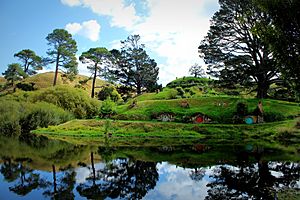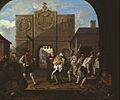Merry England facts for kids
Merry England is an old idea of a perfect, happy English past. People imagined a time when life was simple and joyful. This idea often pictures a peaceful countryside with thatched cottages, cozy inns, and Sunday roasts. It's a bit like a dream world that never truly existed. It shows how people sometimes wish for parts of the past that seem missing today.
Contents
How the Idea of Merry England Started
The idea of a "Merry England" began a long time ago. Around the year 1150, a writer named Henry of Huntingdon first used a phrase meaning "England full of joys." Later, in the 1200s, another writer said that "England is full of mirth and of game."
Medieval Fun and Festivals
Historian Ronald Hutton says that the idea of "Merry England" really grew between 1350 and 1520. During this time, people celebrated many festivals throughout the year. These included parades, games, and special traditions like boy bishops. Many of these fun activities were new creations from the later Middle Ages. They show a time when rural English customs were lively and joyful.
Life for most people in medieval times was often hard. But communities still found time to play and celebrate. The yearly calendar had about 50 holy days for people to gather and have fun. Even though some officials complained about drinking or rowdy games like football, these complaints show how much people enjoyed themselves. Writers like Langland described people drinking ale and singing songs in taverns.
Games and Entertainment in Old England
People in medieval England enjoyed many kinds of recreation. They liked archery, ice-skating, wrestling, hunting, and fishing. Towns and villages also had traveling entertainers. These included musicians, jugglers, performers, and dancers. They brought early forms of mass entertainment to everyone.
So, there was certainly a lot of merriment in Medieval England. However, life was not always easy. After the Black Death, there were fewer workers. This meant farm workers had more power. But changes in farming, like enclosing land, caused new hardships. These problems continued into the Tudor period.
Changes After the Reformation
The Reformation brought big changes to England. It started a long debate about popular festivals. King Henry VIII cut down the number of saint day holidays. He thought these holidays led to too much freedom and bad behavior. His son, Edward VI, reduced them even further.
Clash Over Celebrations
Many traditional celebrations came under pressure. These included church ales, May games, and maypoles. Some people wanted to stop these events because they seemed too Catholic or pagan. Others argued that they made people lazy.
However, many people missed the old ways. In 1552, John Caius complained about losing what he called "the old world, when this country was called merry England." King James I even wrote a book in 1618, called the Book of Sports, defending sports and dancing after Sunday church. His son, Charles I, agreed.
This made "Merry England" a key issue dividing different groups. Puritans, who wanted simpler church services, often opposed these celebrations. Anglicans and those who supported the King often defended them. During the Civil War, Parliament stopped many festivals. Christmas celebrations even went underground as a form of protest. But after the King returned to power in the Restoration, these pastimes became popular again.
How Merry England Was Revived in Culture
Over the years, many writers and artists have brought back the idea of "Merry England." The famous artist Hogarth created an engraving called "The Roast Beef of Old England." It showed English abundance compared to French hardship.
Writers and the Merry England Idea
William Hazlitt helped make the term "Merry England" popular in 1819. He wrote about traditional English sports and country fun. He even linked it to the legendary Robin Hood.
Later, in the 1800s, some groups like Young England hoped to bring back the "old 'merry England'." But others, like Friedrich Engels, thought this idea was unrealistic.
Many writers used the idea of Merry England to comment on changes in society. William Cobbett wrote about the peaceful, pre-industrial countryside in his book Rural Rides. Thomas Carlyle also wrote about "Merrie England" in Past and Present. These writers often compared the past to the new industrial world.
Art and Fairy Tales
The Gothic Revival in the 1830s also helped the idea of Merry England. Artists like Joseph Nash drew beautiful pictures of old English mansions. These pictures showed happy people in old-fashioned clothes. They created an image of a golden, pre-industrial land.
Children's storybooks and fairy tales in the Victorian era often used Merry England as a setting. These stories featured nature-loving creatures like elves and fairies. They also included characters like Robin Hood. Even though Charles Dickens wrote about the past, his stories were more about real life, not fantasy.
The magazine Merry England started in 1879. It used a poem by William Wordsworth that asked if England could still be "merry" despite problems.
Politics and Social Ideas
In the late Victorian era, some politicians also used the idea of "Merry England." It became linked to a vision of a stable society. This society had kind landowners, good farmers, and a happy royal family.
The idea of Merry England was also used by different groups. Some Anglo-Catholics saw it as a generous way of life. Artists like William Morris and the Arts and Crafts movement also believed in parts of it. They imagined a society where people lived in harmony with nature.
Journalist Robert Blatchford wrote a popular booklet called Merrie England in 1893. He imagined a future without capitalism, where people lived in small, self-sufficient communities. This book was very nostalgic for a simpler, rural England before factories and big cities.
Another idea, called the organic community, was promoted by F. R. Leavis. He thought that villages in 17th and 18th century England had a strong, local culture. He believed this was destroyed by the Industrial Revolution. However, historians say that such perfect communities probably never existed.
Deep England: A Special View
"Deep England" is another term for an idealized view of rural, Southern England. It describes what some English people would like to preserve. This idea often goes against modern life and factories. It is connected to writers who love the countryside, like H. J. Massingham.
Famous artists linked to Deep England include writer Thomas Hardy, painter John Constable, and composer Ralph Vaughan Williams. Magazines like This England also reflect this view. During wartime, some propaganda showed a rural Deep England. This was meant to inspire patriotism.
Little England and Wartime Messages
During World War II, the idea of "Deep England" was important for propaganda. It helped create a sense of national unity. Writer J. B. Priestley often talked about the beauty of the English countryside in his radio broadcasts. This happened even when London was being bombed.
However, some people criticized this view. They pointed out that Priestley's descriptions of cottages didn't mention if people living there had good wages or running water. He focused on the beauty, not the reality.
A patriotic song from 1940, "There'll Always Be an England," also used this imagery:
There'll always be an England
While there's a country lane,
Wherever there's a cottage small
Beside a field of grain.
But the song also included images of modern, industrial England. It combined the old and new England to inspire loyalty.
Merry England in Books and Art
The idea of "Merry England" has appeared in many books and artworks. Writers like Rudyard Kipling and the Pre-Raphaelite Brotherhood artists used it. William Morris's 1890 book News from Nowhere showed a future England that had returned to a rural, peaceful life after a socialist revolution.
Children's writer Beatrix Potter and fantasy author J. R. R. Tolkien also used elements of "Merry England." Tolkien's hobbit characters in The Shire live in a way that reflects many "Merry England" ideas.

Some authors have also made fun of the idea. Kingsley Amis's novel Lucky Jim has a character who gives a lecture that ends up making fun of the whole "Merry England" concept.
In Richmal Crompton's William the Bad (1930), a couple tries to bring back "Merrie England." They dress in robes and are vegetarian, which is a funny contrast to the traditional idea of English ale and roast beef. Their pageant, which includes St George and the Dragon, turns into a funny disaster because of William's involvement.
Music and Merry England
The idea of a peaceful, rural England has also inspired music. Composers like Arthur Sullivan used these themes. His ballet Victoria and Merrie England (1897) showed idealized scenes from British history. It included a village celebrating May Day and Christmas. This ballet was very popular.
Another famous work is Merrie England, a comic opera by Edward German from 1902. It has been performed many times by amateur groups in England. German's music often created a romantic image of a "Merrie England."
Other composers also found inspiration in old English tunes and dances. They created works that sounded like music from a past, simpler time.
Some modern music artists also use "Merry England" themes. The Kinks and their leader Ray Davies made an album called The Kinks are the Village Green Preservation Society. It celebrated old English traditions. Ian Anderson of Jethro Tull often sings about an anti-modern, rural vision of England.
See also
- And did those feet in ancient time
- Arcadia
- Civil religion
- C. S. Lewis
- Middle England
- Pastoral
- Robert Herrick
- Sabbatarianism
- Tudor myth
- Whig history
Images for kids
-
O The Roast Beef of Old England by William Hogarth shows English plenty.
-
"A Garland for May Day 1895" woodcut by Walter Crane
-
Poor little birdie teased, by Richard Doyle. Fairy tales often use a "Merrie England" setting.





